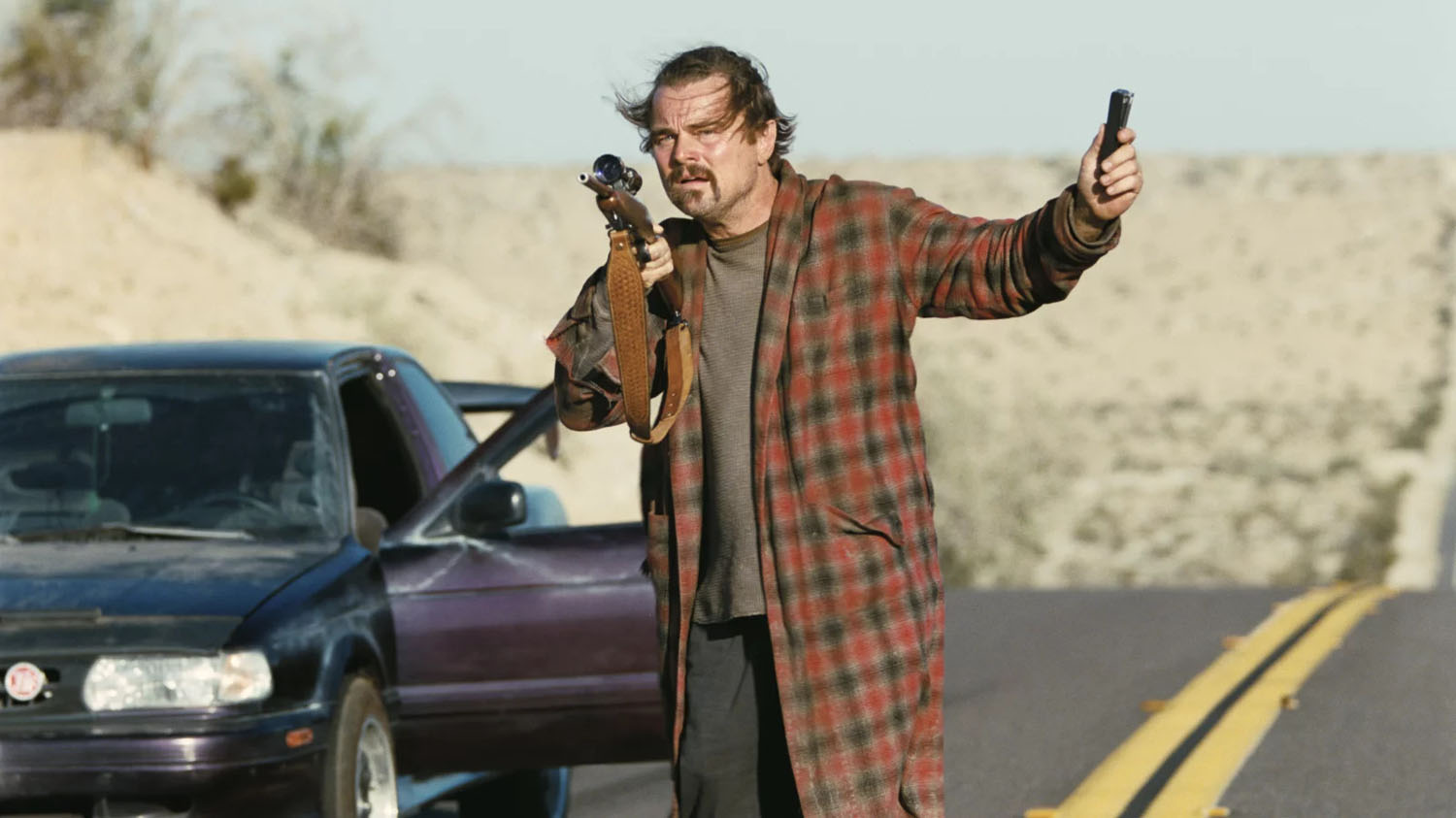By Kevin M. Anzzolin
The city of El Paso takes center stage in director Paul Thomas Anderson’s “One Battle After Another.”
The film follows the fanatical, even surrealistic journey of washed-up revolutionary Bob Ferguson (Leonardo DiCaprio), who lives in hiding with his teenage daughter Willa (Chase Infiniti) some 15 years after his militant group French 75 went underground. When their nemesis Colonel Lockjaw (Sean Penn) resurfaces, Bob and Willa again find themselves running from the law. When Willa goes AWOL, her karate teacher, Sensei Sergio St. Carlos (Benicio del Toro), is enlisted to help Bob find his daughter.
 Kevin Anzzolin
Kevin Anzzolin
Although ambitious, edgy and fun, the political message of the hit film is generally muddled. The immensely talented director did not make a film matching the leftist rigor of, say, “Battleship Potemkin.” Nor can the film be grouped among a veritable cavalcade of films produced during the last 20 years that deal with immigrant issues along the U.S.-Mexico Border. “Sleep Dealer,” “El Norte” and “Who is Dayani Cristal?” are but a few stronger offerings of this cinematic cottage industry.
Nevertheless, the film leans heavy into Latino culture in terms of themes, setting and characters. Filmed largely in El Paso, we meet Sergio, who describes his work helping migrants cross the border as a “Latino Harriet Tubman situation.”
Bob, a fugitive, is known as “The Gringo Coyote.” Sergio explains to him that he’s “a bad hombre” – cheekily invoking the hurtful bon mots used by then-candidate Donald Trump in a 2016 debate with Hillary Clinton.
To what extent does “One Battle After Another” point up truths about the future of Latino labor movements in the United States? Does it offer more than the usually vacuous political bromide that Hollywood consistently creates? What does it add to the conversation about the filmic representations of U.S. Latinos? Finally, does it let the Latino migrant speak?
As others have noted, immigration is a “major motif” in the film: Anderson’s narrative opens with French 75’s liberation of immigrants from the Otay Mesa detention facility.
The Jacobin review can’t contain itself from salivating over the film and its “hard-hitting … up-to-the-minute in its topicality.” The Trump administration’s ongoing militarization of U.S. cities, the increasingly harsh treatment of migrants and the deployment of the National Guard is approaching a nightmarish pitch. The film stages military forces remarkably similar to U.S. Immigration and Customs Enforcement agents.
Discussion of Latino migration to the United States is surprising given Anderson was said to have taken inspiration from Thomas Pynchon’s 1990 novel “Vineland,” a text that includes little talk of the Latino experience. As Time reports, “the biggest difference between text and film is setting.”
It could be proposed that Latino migration is used by Anderson as little more than a prop: a facile stand-in that gestures toward a supposedly politically edgy ethos. Does Anderson’s film take advantage of Latino livelihoods? Are Latinos relegated to background paraphernalia meant to bolster the director’s political bona fides? Or does Anderson use his Hollywood platform to foreground a central issue of our day?
Both ideas are compelling. However, what is incontrovertible is that Anderson did some homework.
Many film locations were shot in El Paso; specifically, the quick-moving scene with DiCaprio on the run was shot around Chihuahuita, a neighborhood fundamentally shaped by waves of immigration spanning over a century. Tellingly, the police pursuit of Bob coincides with an ICE-style raid on the apartment atop Sergio’s dojo, where he has been sheltering numerous Latino families, ostensibly none of whom have documentation.
As Sergio chaperones Bob to a hiding spot, we walk down a long hallway with a typical Anderson steadicam shot. As noted on Ringer Movies, the scene may lack plot but spills over in emotional charge.
As we roll down this hallway, migrants have a face, are given a name. They are family. The families are told to get to El Paso’s Sacred Heart Church, founded in 1892, which has served as a crucial refuge for Mexican immigrants fleeing the Mexican Revolution.
When an official requests “a reason to deploy” in Willa’s town, it is explained that “drugs and tacos” are sufficient cause of invasion. Most tellingly, the main target during the raid is “Rimhorn’s Chicken Lickin’ Frozen Food Farm.” Anderson doesn’t miss the chance to point up the fact that the U.S. poultry industry has thrived off Latino labor.
The film ends with Bob and Willa safe. In the final scene, members of French 75 head to Oakland, California. We’ve never really learned the political mission of the group, other than a vague support of “Free borders, free bodies, free choices and free from (expletive) fear.” At no time does Anderson wade into the nitty-gritty of commodity forms, historically specific modes of production or ideology.
“One Battle After Another” does not point a way out of our doldrums. Beyond the Benicio del Toro character, real Latino lives are not represented deeply. But perhaps in that way it avoids charges of cultural slumming or giving in to a crude ethnographic gaze.
All told, the film points up an incontrovertible truth: any reasonable mission to radically transform society demands that we take to heart the precarity of vulnerable migrant workers, the fact that migration provides an exploitable labor reserve that keeps wages low and profits high.
The Left’s fate in the United States is tethered to that of Latino labor. Perhaps even Hollywood has begun to notice.
Kevin M. Anzzolin, a lecturer of Spanish, teaches a wide range of classes at Christopher Newport University in Virginia.
This <a target=”_blank” href=”https://elpasomatters.org/2025/10/10/opinion-one-battle-after-another-movie-filmed-el-paso-review-latino-themes/”>article</a> first appeared on <a target=”_blank” href=”https://elpasomatters.org”>El Paso Matters</a> and is republished here under a <a target=”_blank” href=”https://creativecommons.org/licenses/by-nd/4.0/”>Creative Commons Attribution-NoDerivatives 4.0 International License</a>.<img src=”https://i0.wp.com/elpasomatters.org/wp-content/uploads/2020/01/cropped-epmatters-favicon2.png?resize=150%2C150&ssl=1″ style=”width:1em;height:1em;margin-left:10px;”>
<img id=”republication-tracker-tool-source” src=”https://elpasomatters.org/?republication-pixel=true&post=107193″ style=”width:1px;height:1px;”><script> PARSELY = { autotrack: false, onload: function() { PARSELY.beacon.trackPageView({ url: “https://elpasomatters.org/2025/10/10/opinion-one-battle-after-another-movie-filmed-el-paso-review-latino-themes/”, urlref: window.location.href }); } } </script> <script id=”parsely-cfg” src=”//cdn.parsely.com/keys/elpasomatters.org/p.js”></script>

